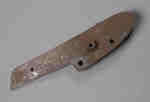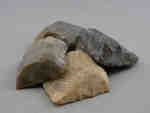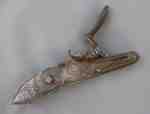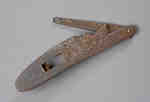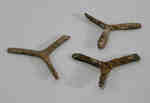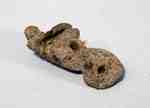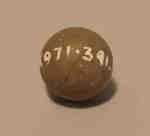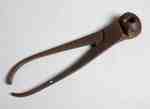Results




Page 1 of 1
- This is a musket action piece that has ornate markings on one side. This item is currently on display at the Battleground Hotel Museum.This is a musket action piece that has ornate markings on one …
- This is a piece of flint that was unearthed at one of Niagara’s Battlefields. It would have been used to light a flintlock musket when firing at the enemy.This is a piece of flint that was unearthed at one of …
- A musket action with “TOWER”, a crown and the Royal cipher “GR” engraved on one side.A musket action with “TOWER”, a crown and the Royal cipher “GR” …
- A Brown Bess rifle, commonly called an India Pattern Musket, that has been previously converted from a flintlock to a percussion action. It is a single 39 inch barrel with three ram rod pipes. ThereA Brown Bess rifle, commonly called an India Pattern Musket, that has …
- This is a musket action piece that has ornate markings on one side. This item is currently on display at the Battleground Hotel Museum.This is a musket action piece that has ornate markings on one …
- These are various pieces of a musket action that were unearthed at one of Niagara’s Battlefields. These items are on display at the Battleground Hotel Museum.These are various pieces of a musket action that were unearthed at …
- These prickers, dated 1812, were used as a screwdriver for a musket. It is “Y” shaped, with the top “V” forming the handle and the bottom arm narrowing to fit into the screw. The musket tool was usedThese prickers, dated 1812, were used as a screwdriver for a musket. …
- This musket, circa 1812, is a 3rd Model “Brown Bess” 1790 with an “India Pattern” design. It was a British regulation issue flintlock musket. There are various engravings on the musket that include:This musket, circa 1812, is a 3rd Model “Brown Bess” 1790 with …
- This is a ramrod guide for a British Tower flint-lock musket that was discovered in Niagara.This is a ramrod guide for a British Tower flint-lock musket that …
- This is the cock from an India Pattern musket of the British Army. It is oblonged shaped with a narrow bottom and a wide top. The top has a hole through it, as does the left side centre. Below is a pThis is the cock from an India Pattern musket of the British …
- This musket, circa 1800, is Brown Bess an “India Pattern” design. The ram rod is missing and there is a make-do front sling swivel. The stock is cracked and the proper right side on the bottom extendThis musket, circa 1800, is Brown Bess an “India Pattern” design. The …
- This original Brown Bess musket is an East India Pattern musket (3rd model) as it has a 39 inch barrel, a brass side plate on the opposite side of the lock and has no tail to it. The tang on the buttThis original Brown Bess musket is an East India Pattern musket (3rd …
- Original donated and identified as a clay musket ball with a circumference of 5cm. It is highly doubtful that such an item would ever be used effectively as a musket ball and is more likely a marbleOriginal donated and identified as a clay musket ball with a circumference …
- This is a lock mechanism measuring 17.7 cm x 3.1 cm, that was made for a tower musket. This lock mechanism was converted to percussion. There are four perforations and markings include “Tower”, a triThis is a lock mechanism measuring 17.7 cm x 3.1 cm, that …
- This is an iron lock mechanism measuring 13.9 cm x 2.5 cm x 3.1cm that is a flintlock from a military pistol. There are seven perforations and markings include “1812”, “2”, and a rampant lion presentThis is an iron lock mechanism measuring 13.9 cm x 2.5 cm …
- This linen bag features red stripes on a white background. The bag was used to carry flints for a flintlock musket. This type of bag was used from the Revolutionary War until 1820. Further research iThis linen bag features red stripes on a white background. The bag …
- Referred to "The Military Arms of Canada" by The Upper Canada Historical Arms Society and "The British Military Longarms 1715-1815' by D.W. Bailey.Referred to "The Military Arms of Canada" by The Upper Canada Historical …
- This is an American metal musket ball mold of a plier design, dated 1812-1814. It was used to press a musket ball to the size of a bore or rifle, approximately .69 calibre musket balls. The press endThis is an American metal musket ball mold of a plier design, …
- This musket, circa1812, with its ramrod attached, is a flintlock converted to a percussion steel firing mechanism. The barrel is steel and the stock is made of walnut. The marks include: the HanoveriThis musket, circa1812, with its ramrod attached, is a flintlock converted to …
Page 1 of 1
When selecting an individual record or object, you will move
to the website of the heritage institution that houses the item.
To return to the search or results pages, select "Back", "Results" or "New Search".
 This project was made possible with the support of the Department of Canadian Heritage
This project was made possible with the support of the Department of Canadian Heritage
through the Canadian Culture Online Strategy.
to the website of the heritage institution that houses the item.
To return to the search or results pages, select "Back", "Results" or "New Search".
 This project was made possible with the support of the Department of Canadian Heritage
This project was made possible with the support of the Department of Canadian Heritage through the Canadian Culture Online Strategy.


